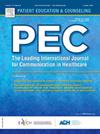Psychometric validation and reliability of the Japanese version of the type 1 diabetes stigma assessment scale (DSAS-1 JP)
IF 2.9
2区 医学
Q2 PUBLIC, ENVIRONMENTAL & OCCUPATIONAL HEALTH
引用次数: 0
Abstract
Aims
We aimed to develop and validate a Japanese version of the type 1 diabetes (T1D) stigma assessment scale (DSAS-1 JP) to measure the stigma perceived and experienced by adults with T1D.
Methods
The DSAS-1 JP was created through forward and backward translations, cognitive debriefing with 10 participants, and extensive proofreading. Its reliability and validity were evaluated in 384 adults with T1D using confirmatory factor analysis, Cronbach’s α for internal reliability, and Spearman’s rank correlation for construct validity.
Results
The DSAS-1 JP was found to be acceptable by the experts and the target population. Confirmatory factor analysis verified the three-factor structure representing ‘treated differently’, ‘blame and judgement’, and ‘identity concern’, with Cronbach’s α values of 0.86, 0.85, and 0.89, respectively. Overall, Cronbach’s α for the DSAS-1 JP was 0.92. The model fit indices were robust (goodness-of-fit index=0.94, comparative fit index=0.94, root mean square error of approximation=0.068). Correlations of the DSAS-1 JP score with diabetes distress (r = 0.60, p < 0.001), self-esteem (r = -0.28, p < 0.001), and depressive symptoms (r = 0.34, p < 0.001) confirmed its constant validity. The test-retest reliability was strong at 0.77 (p < 0.0001).
Conclusion
The DSAS-1 JP is a reliable and valid tool for assessing the extent of perceived and experienced stigma in Japanese adults with T1D.
日本版1型糖尿病病耻感评定量表(DSAS-1 JP)的心理计量学验证与信度
目的:开发并验证日本版的1型糖尿病(T1D)病耻感评估量表(DSAS-1 JP),以测量成人T1D患者感知和经历的病耻感。方法通过前向和后向翻译,对10名参与者进行认知询问,并进行大量校对,形成DSAS-1 JP。采用验证性因子分析,以Cronbach’s α为内部信度,Spearman’s秩相关为结构效度,对384例成人T1D患者进行信度和效度评价。结果DSAS-1 JP被专家和目标人群所接受。验证性因子分析验证了“区别对待”、“指责和判断”和“身份关注”三因素结构,Cronbach’s α值分别为0.86、0.85和0.89。总体而言,DSAS-1 JP的Cronbach 's α为0.92。模型拟合指标稳健性好(拟合优度指数=0.94,比较拟合指数=0.94,近似均方根误差=0.068)。DSAS-1 JP分数糖尿病患者痛苦的相关性(r = 0.60,p & lt; 0.001),自尊(r = -0.28,p & lt; 0.001),和抑郁症状(r = 0.34,p & lt; 0.001)确认其恒定的有效性。重测信度为0.77 (p <; 0.0001)。结论DSAS-1 JP是评估日本成年T1D患者感知和经历耻辱程度的可靠和有效的工具。
本文章由计算机程序翻译,如有差异,请以英文原文为准。
求助全文
约1分钟内获得全文
求助全文
来源期刊

Patient Education and Counseling
医学-公共卫生、环境卫生与职业卫生
CiteScore
5.60
自引率
11.40%
发文量
384
审稿时长
46 days
期刊介绍:
Patient Education and Counseling is an interdisciplinary, international journal for patient education and health promotion researchers, managers and clinicians. The journal seeks to explore and elucidate the educational, counseling and communication models in health care. Its aim is to provide a forum for fundamental as well as applied research, and to promote the study of organizational issues involved with the delivery of patient education, counseling, health promotion services and training models in improving communication between providers and patients.
 求助内容:
求助内容: 应助结果提醒方式:
应助结果提醒方式:


